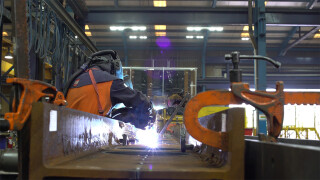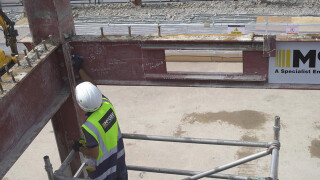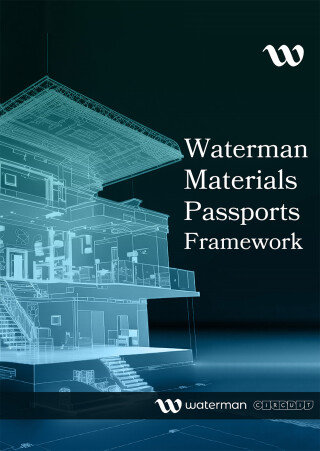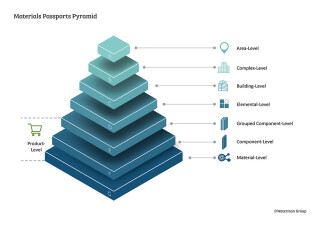There is no doubt about it – the construction sector is a massive net contributor to global carbon emissions.
According to figures from the World Green Building Council some 39% of global energy-related carbon emissions can be laid at the door of buildings. More than a quarter (28%) of this is through operational emissions – the energy needed to heat, cool and power them – with a further 11% from materials and plant used during their construction. Tack on the contributions from the civil engineering and infrastructure sectors and the construction industry’s performance looks even worse.
Latest figures from the United Nations Environment Programme (UNEP) paint a similarly bleak picture. In its 2022 Global Status Report for Buildings and Construction (the 2023 report is due to be published in March 2024) UNEP revealed that despite record investment in building energy efficiency, the sector’s operational energy-related CO2 emissions reached ten gigatonnes – 5% up on 2020 levels – largely thanks to development growth outstripping efforts to improve energy efficiency and reduce overall energy intensity.
It is clear that that if the sector is to reduce its overall impact and help the UK meet its net zero targets, something has to change.
Existing buildings and structures represent enormous banks of reusable materials – structural steel, aggregates, metals, wiring – and their potential for reuse and recycling has long been understood. But it is only recently that the concept of ‘circularity’ – building with a view to eventual deconstruction and reuse – has become part of the planning conversation.
If you want to be overly technical about it, circularity means taking a more regenerative and replenishing approach to the use of resources when we build. It is ‘circular’ insofar as the demolition (or deconstruction) of a structure, instead of being the end-point in a ‘linear’ process, becomes another phase in the lifecycle of the building components and the precursor to another application.

In other words it means reusing whole building parts – for example steel columns or concrete cladding – in the manner in which they were initially intended, before they are recycled.
In an ideal world, a developer intending to regenerate an office block in a city centre would require its project team to survey the existing building before designing its replacement to accommodate as many original parts as possible. Bricks, blocks, structural steelwork – even complex heating and ventilating components – would be reused, making the existing structure akin to an on-site builders’ merchant.
Of course in practice it is a rather more complicated challenge – although one that is not insurmountable, according to Charlie Wedgwood, head of carbon at specialist engineering contractor McGee.
McGee has developed a reputation for taking on some of the most taxing engineering challenges on projects in and around London, including creating a five-storey basement extension beneath uber-posh hotel Claridges and similar work on the transformation of Admiralty Arch.

McGee’s latest challenge is in the City of London where real estate investor Castleforge has appointed it to deconstruct the Cripplegate House office block at 1 Golden Lane.
In what the firm claims as a first, it has devised an approach that will enable existing steelwork to be reused in the proposed new structure. It is ribbon-cutting the existing roof beams down the centre of the flange and refabricating them to create castellated beams, increasing the section stiffness and enabling them to be used in the new development with its greater floor loads.
“We worked with the British Constructional Steelwork Association and consultants London Structures Lab to enable the reuse of the steel,” explains Wedgwood. “The Steel Construction Institute reuse protocol, SCI P427, provides guidance for reclaimed steel produced since 1970, so that gave us a route to get the material verified for use,” he adds.
The project team is targeting the reuse of 60% of the steel from the original building in the new scheme, an approach that London Structures Lab claims will ensure the building has a lower carbon impact than that of a timber frame building with the same overall floor area.
Delivering such a scheme does require a slight change of mindset for project managers: a shift of focus from recycle to reuse first.
“The construction sector has actually been very good at recycling and redirecting material from landfill,” says Wedgwood. “The introduction of the Landfill Tax helped create and mature the recycling industry. There is very little construction waste that goes directly to landfill after its first use now. The challenge now is to do the same for reuse and make that the initial target before going down the recycling route,” he says.
And London could be the focus for that approach, the catalyst being the Greater London Authority’s (GLA) London Plan Guidance for the Circular Economy. This puts the onus on a project’s circularity at the earliest stage possible – when it is being considered for permission by the local planning authority.
It underlines six circular economy principles that it expects developers to have addressed in the design of a proposed scheme. These include designing for longevity; adaptability; designing out waste; and using systems, elements or materials that can be reused and recycled.
The GLA guidance puts particular focus on elements that need to be frequently replaced over the design life of a building, including building services and internal fit-outs, potentially problematic in the fast churn of the London commercial sector.
And while the GLA guidance obviously only relates to work in the capital, there is no reason why planning authorities across the country shouldn’t introduce something similar. City centres all over the UK are undergoing massive redevelopment and often what is trialled in London works its way out to the rest of the UK eventually.
“London is leading the way but all our urban centres can learn from it. Manchester has similar policies too but planning authorities throughout the UK should embrace it,” says Anastasia Stella, sustainability associate at consultant Waterman.
The GLA approach helps push designers to improve the capability of buildings and materials to be reused at their point of highest value but in practice that can be challenging for all parties in the project team. There are few things that engineers and developers like less than uncertainty and risk–and the specification of used or refurbished materials, and products with no warranties and question marks over performance, can carry plenty of both.
Enter ‘materials passports’ – a data collection point that provides information on the identity, specification and performance of materials throughout their lifecycle.

“The challenge we are facing is how to work around the reticence to reuse and reassure those that have concerns over a material’s or product’s performance. Materials passports do that,” says Mark Terndrup, managing director of building services (south) at Waterman.
One of the projects that Terndrup has been working on is the new Edenica office building in Fetter Lane in the City of London. As building services, structural and sustainability engineer on the project, Waterman designed a scheme that minimises operational and embedded carbon and promotes the re-use of materials through the adoption of materials passports (MPs for short). The scheme became a pilot-project for their use.
Passports are being created for the substructure, steel frame, raised access floor and external precast concrete panels, each containing details of each element (including its precise location within the building) and information on materials used during manufacture.
“There are lots of initiatives within the Edenica design to reduce its carbon footprint and it is an ideal project for [main contractor] Mace to trial MPs. We focused on key packages for this scheme, just to make sure everything went smoothly,” says Terndrup.
The project has played a key role in Waterman’s development of its Materials Passport Framework document, one which aims to standardise the approach to creating materials passports across the construction industry, or at least provide a building block to do so.

The firm recognised that there are currently major hurdles for passports to overcome. These range from the perception by some that their introduction adds another layer of complexity to a project, to the simple lack of digital tools that facilitate their production and updating. In a bid to conquer these hurdles, Waterman’s Anastasia Stella has spearheaded the development of its passport framework document.
This aims to “establish the initial stage toward a consistent and standardised framework for the production and lifecycle management of MPs for products, materials and elements in the built environment”.
The document strips the delivery of materials passports down to basics, suggesting a seven-tier pyramid structure that defines passports for materials (paint, bricks, concrete etc) at the base followed by components (such as piles, precast beams, steel columns) and grouped components (e.g. aluminium-framed windows or timber-and-steel desks).

Above these are passports at an elemental level (which provides an overview of the recorded information for components classified under a specific building element category), building level (which provides a comprehensive overview of the recorded information for a specific building), complex level (similar to building level passports but with an overview of the recorded information for multiple buildings within a complex) and area level (a passport that provides an overview of the recorded information for all the buildings where materials passports have been produced in a specific area) at its apex.
“We wanted to provide a starting point for the standardisation of MPs,” says Stella. “They enable developers to understand the value of their asset and can also help unlock ‘green’ investment.”
Multiplex, another business that has embraced the use of materials passports, has recently completed their trial use at its One Nine Elms development in Vauxhall, south London, as part of its net zero target.
In a bid to help reduce embodied carbon the firm used material passports, expressly focusing on the more difficult-to-manage fit-out elements including bespoke stonework, tiles, screed, insulation and bathroom fixtures, in the development of the new luxury hotel at the site.
“We wanted to test the use of MPs on the more complicated elements and bespoke stonework,” says Jess Elliot, Multiplex’s head of sustainable design and building. “There was a lot of head-scratching but the buy-in from our supply chain helped”.
Part of that supply chain is the specialist consultant Maconda Solutions, which worked with Multiplex using software from specialist developer Upcyclea to gather information on the materials used in the hotel.
This data was used to produce scores for the scheme’s carbon footprint, circularity, material health and its financial residual value, helping Multiplex to develop the project’s ‘circular signature’ – the equivalent of a built asset’s carbon footprint.
At One Nine Elms almost 1,500 tonnes of material was covered by the passports with studies showing that more than 40% of the initial materials cost of the cladding elements could be recovered using existing reuse and recycling routes.
Providing all this data on the potential for reuse of building elements and construction materials is all well and good – but how can it be used for the benefit of future developments on a practical level?
On a single-site level future designers will know exactly what they are working with
as they look to redevelop a site from, say, commercial to residential use. They will be able to look at an existing building and make informed decisions about the structure’s potential for reuse, both onsite and on other developments.
The use of materials passports could support the development of a UK-wide stock database, enabling developers planning a scheme in Bristol to mine a project in Birmingham for materials and elements cleared and certified for use, thus reducing demand for brand new products and raw materials.
This idea of ‘urban mining’ and material exchange is some way off becoming reality and there are numerous challenges still to overcome. For example, there is simply not the storage capacity for thousands of tonnes of materials at present.
“There needs to be a cross-industry strategy to develop material reuse and create portals for material availability so that we can work to maximise circularity potential,” says Multiplex’s Elliot. “At the moment we have so much material availability but just no space. We need to identify the route to reuse,” he adds.
For Charlie Wedgwood the approach would be to make sure developers recognise their asset’s value initially and look at the potential for reuse across their projects.
“Developers need to start viewing assets as carbon banks and look across their portfolios. The first step in doing that is to survey existing buildings and understand exactly what is available. It would be nice to have an open market for materials and products. As an industry we’re doing the minimum at the moment but beginning to move in the right direction,” he says.
The team at Waterman is convinced the use of materials passports will be fundamental in the battle to reach net zero targets.
“Ultimately we see the introduction and use of material passports linked to the UK Net Zero Carbon Buildings standard. They could be the tool that unlocks the potential to reach that net zero target,” says Mark Terndrup.
As the market for reused materials starts to grow then its trajectory could reach the point where, thanks to carbon taxation, the cost of raw materials begins to eclipse that of reused elements. As more developers recognise the value they have locked up in their assets, then moves to realise that value will take off. Just don’t forget your passport.

Mace’s vision of a circular London
Last year contractor Mace published a report, Closing the circle, calling for London – and particularly the City of London – to become the “circularity capital of the world”.
The report noted that while 90.2% of waste from London’s demolition and construction sites is currently recovered for reuse or recycling, most of it does not end up back in the construction sector, which remains dependent on importing virgin materials.
What is needed, the report argues, is a closed materials loop that would cut the lifecycle emissions of redevelopment projects and reduce their costs.
Mace claims that by adopting circularity, around 13.8 million tonnes of materials would remain within the construction supply chain over the coming decade. If produced new, these materials would generate 11.8 million tonnes of CO2, or 3.6% of the UK’s total emissions, it says.
The report recommended that, to put London in a leading position in the global circular construction economy, it should:
- Develop physical and virtual ‘circularity material banks’ that enable smaller companies to take advantage of materials produced elsewhere in the industry
- Introduce materials passports that track the source of materials within the supply chain and enable easier re-use
- Bring industry and government together to build a credible circularity accreditation scheme to allow clients, investors and contractors to demonstrate the value of their commitment to circularity.
- James Low, head of responsible business at Mace, said: “We must be able to deliver zero embodied carbon buildings and infrastructure within our lifetimes and we believe that the transition to a circular economy is among the most important innovations and system changes required to achieve that.”
Got a story? Email news@theconstructionindex.co.uk




